26.09.2005
N. Vitiugov. A Key Game or The Last Round
Chess gourmets, pure art lovers and those who just prefer beauty, l conjure you not to read this article. Respected chess teachers, do not allow your pupils to read this! Readers zealous to see beautiful combinations and profound strategies will find nothing interesting here. Generally speaking, this article is not about chess, or more strictly speaking, not about what is usually called chess. When we say that someone is a good chess player, what do we really mean? We mean that he has more or less decent openings, knows the minimum of typical strategic ideas, can play endgame in accordance with the classics, and can calculate for more than three moves ahead. What else? Ok, let' add ability not to get lost facing unknown positions, not to give up being caught in the opening and also notorious fighting spirit as a bonus. Good identikit from my point of view. Not an elite player of course, but not a candidate master.
And now let us come back from visual art I hate since my childhood back to the topic of the article. It does not matter how many rounds there are in a competition, there is always the last one. And for sure everyone mentioned that if there are nine rounds, then a player is absolutely exhausted in the ninth round, if there are ten, then in the tenth, and if eleven, then in the eleventh. It can be easily explained – one disposes oneself to a certain period of severe trials, "programs" oneself, and then relaxes frequently in front of the last obstacle (I don't know why it happens, you should seek the reason in sphere of psychology, but this statement is unlikely to be debated). It is interesting that if the player is "out of gas" earlier, then the organism mobilizes exceedingly. Maybe real sportsmen' organisms are even ready to "eat themselves" (not in literal meaning, you know) just to have any food that is of vital importance at the moment. It is called to play at one's last gasp.
A chess player is always tired when the last round comes. It does not matter how much he loves chess, how fit and tough he is. He is just tired.
Last round is usually scheduled differently (we are talking about the Swiss, played by majority of professionals). Usually in the morning. And it means changing the routine, it means sacrifice. To sleep less, to rest less, to prepare less – it's one's personal choice.
The natural consequence of the reasons mentioned above is a huge increase of the blunder rate: people tend to lose in the opening and make technical mistakes. And leave the technical stage apart, assessment of the position often changes almost on every move.
If you have any claims before the last round (and we are going to speak only about such cases in this article), then in such difficult situation you should prepare yourself for the most important game of the tournament (the cases of banal prearranged games also wouldn't be considered here). Defeat cannot be considered a good result (if you have not got at least 1.5 points more than all of your pursuers), and there is a huge difference between a victory and a draw. This difference exists for both finance and career. You can regularly get +3 and show the stability that is worth esteem, or burst once after a chain of losses, win the Swiss and rise better than in the first case.
How should one play chess thinking that in case of victory one gets this and that? First of all, one should stop thinking about anything except chess (as far as I remember it is called concentration). The main thing is chess, and all the benefits, numerous press conferences, photo sessions and advertising contracts come afterwards. It is also important to start with an opening the opponent is not familiar with (it is not the appeal to make a move like 1.f3). It does not mean that one needs to catch in the opening (usually it is not done either because of the absence of time or the danger of being caught instead), but one has to chose the type of positions unknown to the opponent. Last round is also time for single-serving schemes – they are rarely studied and the opponent might lack strength to refute them during the game.
It is extremely important not to try to reach the aim immediately. It is not just important, it is decisive from my point of view. It is important to understand and adopt the idea that in the last round there are also 32 pieces, and 16 of them are yours. There are still 64 squares on the board. To sum it up, chess is the same and only stakes are high. If chess stayed the same you should play as usual. Only in the turning points of the game one should remember that there would be no more chance to improve the result, and the result in the final standings would be written after this very game. One should not try to gain forced victory, it is better and easier to increase tension: fear has big eyes and the opponent will have hard times. Playing White after a victory as Black in the knock-out, one should not exchange all and everything, but make best moves and not think about the result. The example is the 6th game of the match Khalifman-Akopian. The schemes with the g7-bishop (the Alekhine's defense, the Benoni defense, the Dragon Variation, the Pirc defense) are the most popular for Black.
The reader would say something like: "You are so extremely clever, dear author, so why do you write articles instead of fighting for the participation in the championship of the world?" – and he will be right. Ok, I shall stop. Before every game I will say a few words about the opponents' tournament situation. Annotations will be a bit specific – one should bear in mind the fact that one of the opponents does not agree with the way game goes.
V.Kramnik – P.Leko
Brissago 2004
What can be more decisive than the last game in the world championship match (although it is not clear whether it was candidates or championship match)? After the misfortune in the first game Peter Leko braced up and snagged the strategic initiative. And he did it so good that the throne began to shake under Vladimir Kramnik. And here is the ending. In the previous game Leko was about to lose, but managed to hold. Thus the last game bears the whole weight of the struggle. A game in which the championship title is at stake is an outstanding event. Let's remember the K&K confrontation and the concluding game of the Seville match. Kasparov acted in a sneaky mode unusual for him, aiming for a long struggle. When there was almost no material left on board, Karpov made a decisive mistake, missing his way to a draw. In this game Vladimir chose the analogous strategy, deviating from major theoretical ways as early as on the 6th move.
1.e4 c6 2.d4 d5 3.e5 Ґf5 4.h4 h6 5.g4 Ґd7 6.¤d2!? Right! You should force an opponent to play in one of the main games of your life. What is it all about? Rash development of the theory leaves almost no unknown opening areas. As a result, we mainly show good memory and not good chess.
6...c5 7.dxc5 e6?! Leko plays with the weight of responsibility – he did not have to limit the d7-bishop so early. 7...¤c6!? 8.f4 (8.¤b3 ¤xe5 9.Јxd5 Ґxg4 10.Ґb5+ ¤c6 11.Ґxc6+ bxc6 12.Јxc6+ Ґd7„) 8...e6 (8...h5!?) 9.¤b3 Ґxc5 10.¤xc5 Јa5+ 11.c3 Јxc5 12.¤f3 ¤ge7 13.h5›; 7...Јc7!?
8.¤b3Ґxc5. In the recent Superfinal of the Russian women's championship 8...¤c6?! was tested, but without any success: 9.¤f3 Јc7 10.Јe2 ¤a5 11.Ґe3 ¤c4 12.Ґd4 ¤e7 13.c3 ¤c6 14.Ґg2 Ґe7 15.¤c1 ¤xd4 16.cxd4 Јa5+ 17.ўf1 b6 18.¤b3 Јb4 19.¤e1 0–0 20.ўg1 a5 21.cxb6 Јxb6 22.¤d3 Ґb5 23.¤bc5І Kosteniuk-Gunina, Samara 2005.
9.¤xc5 Јa5+ 10.c3 Јxc5
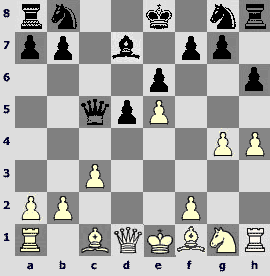
Although White's advantage is minimal, he won the opening battle. The main point is that the opponent has no counterplay. Then White has to increase the tension without any hurry (and Kramnik really knows how to do that), and Black will not bear it for a long time. And if he would, then White can add a bit more, and so on. It is a struggle, Russian football, but not chess.
11.¤f3 [11.Ґe3!?] 11...¤e7 12.Ґd3 [12.h5] 12...¤bc6 13.Ґe3 Јa5 14.Јd2. The developing stage is about to end. The only thing left is to place the kings.
14...¤g6 15.Ґd4 [15.Ґxg6?! fxg6=] 15...¤xd4?! Objectively not a bad move, but the Russian was glad to see it. Black agrees to defend without any counterplay in prospect, my apologies to respectable Peter Leko. Queens had to stay on board – 15...Јc7 16.Јe3 ¤xd4 17.cxd4 (17.Јxd4 ¤e7 18.Јe3 ¤c6 19.h5) 17...Јb6 18.0–0–0!?›.
16.cxd4 Јxd2+. 16...Јb6 was also possible, but Black had another reason for strengthening White's center.
17.ўxd2І
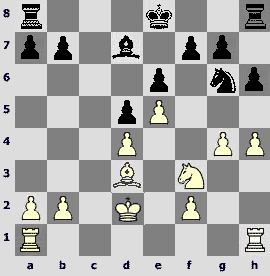
White has the advantage. It is not "a little bit more pleasant", it is real advantage – light-squared black bishop is too bad and Black's position is too constrained, and he has very few counterchances.
17...¤f4. 17...¤e7 looked more passive.
a)18.ўe3?! ¤c6 19.¤d2 (19.g5) 19...f6 20.f4›;
b)18.b4!? a6 19.a4 f6 20.b5 axb5 21.axb5 ¦xa1 22.¦xa1 ўd8 23.exf6 gxf6 24.¦a8+ ¤c8 25.b6 ¦f8 26.¦b8 e5 27.dxe5 Ґxg4 28.¤h2 Ґd7 29.e6 Ґxe6 30.¦xb7 ¤d6 31.¦b8+ Ґc8 32.Ґa6 ўd7 33.b7ќ Mellema – Hiemstra, Hoogeven 2004;
c) 18.¦ac1! a6 19.¦c5 Ґc6 (19...¦c8 20.¦xc8+ Ґxc8 21.¦c1І) 20.h5І.
18.¦ac1! Seizing the file is more important than the bishop! But possibly 18.Ґf1!? h5 19.g5 (19.¦g1!?) 19...¦c8 20.ўe3 ¤g6 21.Ґd3І would be also good. Despite the fact that the kingside is locked, White has spatial advantage and some pressure.
18...h5. White's position on the kingside is slightly spoiled.
18...¤xd3?! 19.ўxd3 Ґb5+ 20.ўe3 ўd7 21.h5 ¦ac8 22.¤h2! ¦hf8 (22...¦xc1 23.¦xc1 ¦c8? 24.¦xc8 ўxc8 25.f4 ўd7 26.g5ќ) 23.f4 a5 24.¤f3± – White has a clear-cut plan, and where is Black's counterplay is out of my understanding.
19.¦hg1 Ґc6?! It will be evident soon that Black did not manage to block the file but rather went under attack. However, it was really difficult to predict it at the moment. 19...¤h3 20.¦g3! ¤xf2 21.gxh5ѓ; 19...¦c8 20.¦xc8+ Ґxc8 21.gxh5 ¤xh5 22.ўe3 Ґd7 23.¦c1 ўd8 24.¤g5 ¦f8 25.Ґe2!±.
20.gxh5 ¤xh5?! Such a natural move is a mistake. Why? It allows some motives on the diagonal... e8-h5, which are favorable for White. 20...ўf8!? 21.Ґb1 ¤xh5 22.ўe3І.
21.b4 a6 22.a4!±
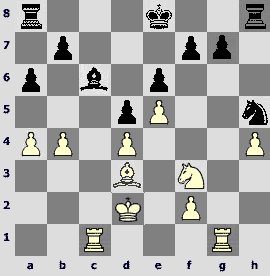
A very strong pawn sacrifice. If Black accepts it, then his rooks will be unable to move away from starting positions. If not, he will lose more space and White will take an absolute control over the c-file.
22...ўd8
22...Ґxa4 23.¦c7 Ґb5 24.Ґb1!
a) 24...0–0 25.¦g5 ¤f4 (25...g6 26.Ґxg6 fxg6 27.¦xg6+ ўh8 28.¤g5ќ) 26.ўe3 ¤e2 27.Ґd3 Ґxd3 28.ўxd3 ¤f4+ 29.ўe3 ¤g6 30.h5 ¤h8 31.h6 g6 32.¦g1±;
b) 24...b6 25.¤g5 0–0 26.Ґh7+ ўh8 27.Ґc2 Ґe8 28.Ґd1 ¤f4 (28...g6 29.Ґxh5 gxh5 30.¦a1) 29.ўe3 f6 30.¤h7 ¦f7 31.¦xf7 Ґxf7 32.exf6±;
с) 24...Ґd7 25.¤g5±.
Black should have tried 22...ўe7!? 23.b5 axb5 24.axb5 Ґd7 25.¦c7 b6 26.ўe3, and here active 26...¦a3 (26...¦hc8 27.¦b7 ¦cb8 28.¦xb8 ¦xb8 29.¦a1±) gave some chances to Black – 27.¦b7 ¦c8 28.¦b1 (28.¦d1!? ¦cc3 29.¤e1) 28...¤f4 29.ўxf4 ¦xd3 30.¦a1! ¦cc3 31.¦aa7 ¦xf3+ 32.ўg4 ўe8 33.¦xd7±.
23.¤g5 Ґe8 24.b5. He doesn't need to hurry – 24.ўe3!?
24...¤f4? A decisive mistake. Activity will not help any more. He had to "stand". 24...axb5 25.Ґxb5 b6 [25...¤f4? 26.ўe3 ¤g6 (26...f6 27.¤f7+! Ґxf7 28.¦xg7ќ) 27.Ґxe8 ўxe8 28.¤xe6ќ] 26.¦c3!? (26.ўe3!?) 26...¤f4 27.Ґc6!? ¦a7 28.Ґxe8 ¦xe8 29.ўe3 ¤h5 30.¦gc1ѓ.
25.b6!ќ
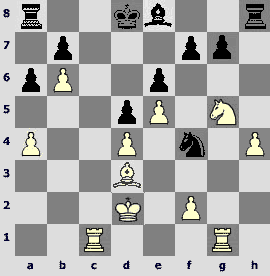
Rook invasion to the 7th rank cannot be prevented. It is a pity that Black cannot even complicate White's realization of the advantage.
25...¤xd3 [25...¦c8 26.¦xc8+ ўxc8 27.¦c1+ ўb8 28.¦c7ќ] 26.ўxd3 ¦c8 27.¦xc8+ ўxc8 28.¦c1+ Ґc6 29.¤xf7 ¦xh4 30.¤d6+. Knight has occupied an optimal position. It is time to improve rook and king.
30...ўd8 31.¦g1 ¦h3+ 32.ўe2 ¦a3 33.¦xg7 ¦xa4 34.f4 ¦a2+. On 34...¦xd4 an elegant variation 35.f5! exf5 36.e6 ¦e4+™ 37.¤xe4 fxe4 38.¦c7!ќ leads to victory.
35.ўf3. White king march cannot be stopped. 35.ўd3 ¦a3+ 36.ўc2 ¦a2+ 37.ўb3 ¦f2 38.f5 exf5 39.¤xb7+ Ґxb7 40.¦xb7 ¦e2 41.¦f7ќ.
35...¦a3+ 36.ўg4 ¦d3 [36...¦a1 37.¦h7 ¦g1+ 38.ўf3 ¦f1+ 39.ўe3] 37.f5!
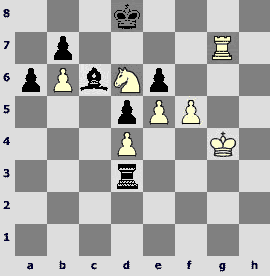
The last finesse. The c6-bishop... you know.
37...¦xd4+ 38.ўg5 exf5 39.ўf6 ¦g4 40.¦c7 ¦h4 41.¤f7+ 1–0 [41...ўe8 42.¦c8+ ўd7 43.¦d8#]
D.Jakovenko –D.Khismatullin В92
Tomsk 2004
Disposition is like that – two young grandmasters, both having +2, struggle for the place in the Superfinal of the Russian championship. Only a victory gives them a chance.
1.e4 c5 2.¤f3 d6 3.d4 cxd4 4.¤xd4 ¤f6 5.¤c3 a6 6.Ґe2 e5 7.¤b3 Ґe7 8.0–0 0–0 9.ўh1 Ґd7 10.Ґe3 Ґc6. A rare variation and not a bad one (it was the way Kasparov played) is exactly what one needs in the last round.
11.f3. It seems that it is better not to allow the d6-d5 breakthrough. 11.Ґf3!? ¤bd7 12.a4 b6 13.Јd3 Ґb7 14.h3 ¦c8 15.¦ad1 h6 16.¦fe1 Јc7 17.g3 ¦fd8 18.ўh2 ¦e8 19.¦e2 Јc4 20.Јxc4 ¦xc4 21.¤d2 ¦c7 22.Ґg2 ¦ec8 23.¤b3 ¦xc3 24.bxc3 Ґxe4 25.Ґc1 Ґxg2 26.ўxg2 ¦xc3 27.Ґa3 ¤e8 28.f4 Ѕ–Ѕ "Deep Junior" – Kasparov, New York 2003.
11...d5 12.exd5 ¤xd5 13.¤xd5 Ґxd5
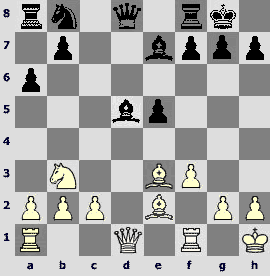
This position occurred in the first round of the same tournament in the game of the future Superfinal participant. Let's mention that his position was doubtful but he won in the opponent's time trouble: 14.Јe1 Јc7 15.c4 Ґe6 16.Јg3 f5 17.f4 ¤c6 18.¤c5 Ґxc5 19.Ґxc5 ¦f7 20.Јe3 ¦e8 21.¦ad1 exf4 22.Јxf4 Јxf4 23.¦xf4 ¦d7 24.¦xd7 Ґxd7 25.¦f2 ¤e5 26.h3 ¦c8 27.Ґd4 ¤xc4і Timofeev-Loskutov, Tomsk 2004.
14.c4 Ґc6. 14...Ґe6 15.¤c5 Ґxc5 16.Ґxc5 is worse, and White has an advantage of two bishops.
15.Јxd8 ¦xd8 16.¤a5. It would be more promising to send the knight to another square – 16.Ґb6!? ¦e8 17.¤c5 ¤d7 (17...Ґd8 18.Ґxd8 ¦xd8 19.¦ad1 ¤d7 20.¤xd7 ¦xd7 21.¦xd7 Ґxd7 22.¦d1І) 18.¤xd7 Ґxd7 19.¦ad1 Ґe6 20.b3 with minimal advantage.
16...Ґb4?! The ultimate solution of the opening problems was 16...¤d7!? 17.¦ad1 (17.ўg1!? Ґc5 18.ўf2) 17...Ґc5 18.Ґg1 Ґxg1 19.ўxg1 ¤c5=.
17.Ґb6. 17.¤xc6!? ¤xc6 18.a3 Ґe7 …19.¦ad1 ¤d4 20.Ґd3 looked interesting.
17...¦d2 18.¦ad1 ¤d7. The one to lose was 18...¦xe2 19.¦d8+ Ґf8 20.Ґc7!ќ – a beautiful quiet move (20.Ґc5?? ¤d7!°; 20.¤xc6? bxc6 21.Ґc7 ¦a7! 22.Ґxb8 ¦a8і).
19.¦xd2 ¤xb6! [19...Ґxd2 20.¦d1 Ґxa5 21.Ґxa5І]
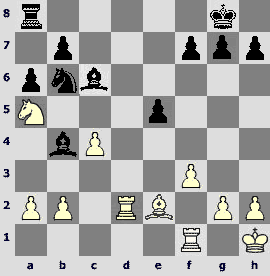
Pieces fly off the board one by one. What can be interesting about it? Where is a promised tension and, more important where are the mistakes?
20.¦fd1 Ґxd2 21.¦xd2 ўf8 [21...¤a4?! 22.¦d6 ¦c8 23.¤xc6 bxc6 24.c5! ¤xc5 25.b4 ¤b7 26.¦d7І] 22.¤xc6. Another type of positions could appear as the result of 22.c5!? ¤d5 23.ўg1 (23.¤c4!? f6 24.¤d6) 23...ўe7 24.¤c4 f6 25.¤d6 g6 26.Ґc4 ¤c7 27.ўf2І.
22...bxc6 23.¦d6 ¤a4 [23...¦c8? 24.c5 ¤a4 25.Ґxa6 ¦b8 26.b3±] 24.¦xc6?! is the first inaccuracy of White. 24.c5! a5 was stronger (24...¦c8?! leads the game to the previous comment) 25.¦xc6 ¦d8 26.ўg1 ¤xb2 (26...¦d2!? 27.Ґb5 ¤xb2І) 27.¦a6І.
24...¦b8! 25.h4
25.¦xa6? ¤c3! 26.Ґd3 ¦xb2=; 25.b3 ¤c3 26.Ґf1 ¤xa2 27.¦xa6 ¤c1 28.c5 ¤xb3!? (28...¦xb3? 29.¦a8+ ўe7 30.¦a7+ ўf6 31.c6±) 29.¦b6 ¦xb6 30.cxb6 ¤c5 31.Ґc4 ўe7=. White's remote passed pawn is on one hand strength, and on the other – weakness. Position is equal because white king is too far away.
25...¦xb2 26.Ґd3 [26.¦xa6!? ¤c3 27.Ґd3 ¦xa2=] 26...g6. Why not to defend the pawn? 26...a5!?„ .
27.c5? Somewhere here White goes too far. Why not to eat the pawn? 27.¦xa6.
27...¦xa2 [27...a5 28.¦c7 ¦xa2 29.c6 ¦a1+ 30.ўh2 ¦c1 with more chances for Black] 28.ўh2. The a6-pawn is almost a phantom. Whether it exists or not is the philosophic question. So I would not mention variations associated with its capture or defense further.
28...¦d2 29.¦c8+ ўe7 30.Ґxa6

Or as a matter of fact it existed...
30...¦c2 31.c6 ¤b6. It would be interesting to move the knight to e6 – 31...¤c5!? 32.Ґb5 ¤e6і, but the move in the game is also nice.
32.¦c7+ ўe6 33.Ґd3 ¦c1 34.h5. It must be a time trouble complication. A draw is equal to a defeat for both players so straight on! 34.Ґb5!? is fairly stronger but such moves are the last to be considered in a time trouble.
34...gxh5 35.f4? [35.Ґb5!?] 35...¤d5! [I could not understand what would have happened in case of 35...exf4] 36.f5+ ўf6 37.¦d7
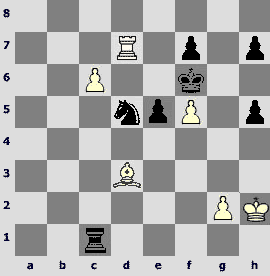
37...¤f4?? Defeating the opponent in the ending (or just using his inaccuracy, I do not know which is more correct), Black makes a blunder at the decisive moment. 37...¤e3! 38.c7 (38.Ґe4 h4 39.Ґf3 e4! 40.Ґxe4 ¤g4+°) 38...h4 39.g3 ¤g4+ 40.ўg2 h3+!°.
38.Ґe4ќ. The c-pawn cannot be stopped. 38...h4 39.c7 ¤e2 40.¦d6+ ўg7 41.¦c6 1–0
Jakovenko won but was unfortunately finished fourth with only 3 players advancing. White's 34th and 35th moves are a classic example of burning the bridges for the sacred aim. In this game Black was unable to punish his opponent for a too risky play.
Two subsequent games are the examples of different play for a win as Black. And in both games White also needed a victory. Vaganian played a strong opening on the solid positional basis and Alexander Stripunsky made the claim to play creatively from the very first move.
J.Lautier – R.Vaganian D31
Moscow 2004
The Aeroflot open-2004. It is not a struggle for the first place, but every half-point in this tournament is literally golden.
1.d4 d5 2.c4 e6 3.¤c3 Ґe7 4.cxd5 exd5 5.Ґf4 c6 6.e3 Ґf5 7.¤ge2. In this calm opening nothing yet betokens White's problems. 7.g4!? Ґe6 8.h3 ¤f6 9.Ґd3 c5 10.¤f3 ¤c6 11.ўf1 0–0 12.ўg2 cxd4 13.¤xd4 ¤xd4 14.exd4 ¤d7 15.Јc2 ¤f6 16.f3!І Botvinnik-Petrosian, Moscow 1963.
7...¤d7 8.f3 Ґg6! 9.Ґg3?N. A very doubtful bishop transfer to f2. What is the use of moving a bishop to a passive position from an active one? Joel Lautier is an excellent positional chess player. He would have never played like this except for the game in the end of such a difficult tournament. Maybe he was too tired. 9.g4? h5=; 9.¤g3!?
9...¤h6! Perfect reaction! During next moves White will either become passive or weak and Black will become active.
10.Ґf2 Ґd6 11.g4 f5 12.h3 0–0 13.Ґg2 Јe7і
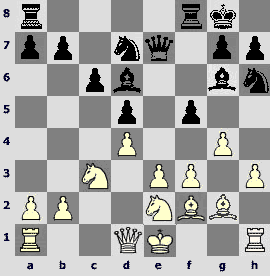
We can sum up the results of the opening: Black has comfortable advantage.
14.0–0 fxg4 15.hxg4 Јg5 16.Јd2 ¦ae8. Black pieces are the huge thundercloud over the White's kingside. Dreadful rain is coming...
17.¦ae1? Failingto sense the danger. He had to try to jettison the ballast – 17.¤f4!? ¦xf4!? – no doubt Vaganian would have played like that (17...Ґxf4 18.exf4 Јxf4 19.Јxf4 ¦xf4 20.¦fe1і, and Black has to work hard to win) 18.exf4 Ґxf4 19.Јd1 ¤f7 20.¦e1 ¦f8! White pieces are miserable, especially the light-squared bishop. Black has good compensation, but the result of the game is still unpredictable.
Preventive 17.¦ad1!? ¦xf3 18.Ґxf3 ¤xg4 19.e4 was also possible. It was the idea of White's 17th move – the queen is protected.
а) 19...¤e3+ 20.¤g3 Ґxg3 21.Ґxe3 Ґf4+ 22.ўf2 Јg3+ 23.ўe2 dxe4 24.Ґxe4™ Јg4+! 25.ўd3 (25.Ґf3 Јh4µ, and Black continues the attack, having two pawns for an exchange) 25...Ґxe3 26.Јxe3 ¤f6 27.Јf4 Ґxe4+ 28.¤xe4 ¦xe4 29.Јxg4 ¦xg4і, and there are two possible results in the ending.
b) 19...¤xf2+!? 20.Јxg5 ¤h3+ 21.ўg2 ¤xg5 22.exd5 [22.e5 Ґxe5!? (22...Ґe7і) 23.dxe5 ¤xe5 24.Ґxd5+ cxd5 25.¦xd5 ¤e4©] 22...¤xf3 23.dxc6 ¤h4+ 24.ўh3 ¦e3+ 25.ўxh4 bxc6і is also interesting.
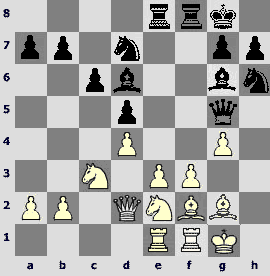
17...¦xf3!! 18.Ґxf3 ¤xg4 19.Ґg3?! 19.Ґxg4!? Јxg4+ 20.¤g3 is better, and here delicate 20...¦f8 leadsto the victory (20...Ґxg3?! 21.Ґxg3 Јxg3+ 22.Јg2 ¦xe3 23.Јxg3 ¦xg3+ 24.ўh2 ¦d3 25.¦e7 ¤f6 26.¦xb7 ¦xd4µ – is worse. Although Black's position is good, White can try to find a chance): 21.e4 (21.Јe2 ¦f3; 21.¤ce2 Ґe4 22.¤f4 g5°) 21...Ґxg3 22.Ґxg3 Јxg3+ 23.Јg2 ¦xf1+ 24.¦xf1 Јxg2+ 25.ўxg2 dxe4µ, and there is no use in further resistance.
19...¤xe3 20.ўh1 Ґh5!!°

Beautiful sneaky move that had to be seen 3 moves ago. By the way, there is no other way to the victory.
21.Ґxh5. Now even 21.¤f4 ¤xf1 22.¦xf1 Јxg3 23.¤xh5 does not help(23.Ґxh5 Ґxf4 24.Јxf4 Јh3+°) 23...Јh3+ 24.ўg1 ¤e5!! – a perfect blow! 25.Ґd1 (25.dxe5 Ґc5+ 26.¦f2 Јxf3°) 25...¤c4 26.Јg2 (26.Јf2 ¦f8°) 26...Јxg2+ 27.ўxg2 ¤e3+°.
21...Јxh5+ 22.ўg1 Јh3 23.¦f2 Ґxg3 24.¤xg3 Јxg3+ 25.¦g2 ¤xg2 26.¦xe8+ ўf7 27.¦c8 ¤e3+ 28.ўh1 ¤f6 0–1
Rafael Artemovich showed an outstanding play. The attack after a blow on the 17th move was eminent, and in all variations Black not simply wins, but wins with elegance.
A.Goldin – A.Stripunsky B01
San Diego 2004
The concluding round of the USA championship. Goldin trails half a point behind Nakamura (who plays with Ibragimov as White) and behind Stripunsky, his opponent in the game. A very complicated situation, but it is clear that both opponents need victory.
1.e4 d5!? 2.exd5 Јxd5 3.¤c3 Јd6 4.d4 ¤f6 5.¤f3 a6 6.Ґe3. The fact that this scheme is not that harmless is proved by the game: 6.g3 Ґg4 7.Ґg2 ¤c6 8.0–0 0–0–0 9.d5 ¤b4 10.Ґf4 Јc5 11.Ґe3 Јd6 12.Јc1 ¤bxd5 13.¤xd5 ¤xd5 14.¦d1 Јf6 15.Ґg5 Јf5 16.¤h4 Јe6 17.Јd2 Ґxd1 18.¦xd1 h6 19.Ґe3 g5 20.Јd4 Ґg7 21.Јa7 c6 22.Ґc5 gxh4 0–1 Glek-Muhammad, Minneapolis 2005
6...b5 7.Ґd3 Ґb7 8.0–0 ¤bd7 9.Јe2 e6 10.Ґg5. acknowledging the tempo loss. White could have played Ґg5 at once if he wanted. An alternative was 10.a4 b4 11.¤b1 c5 12.¤bd2 with complex game.
10...Ґe7 11.a4 b4 12.¤e4 Јd5„. Black could have equalizes with the help of 12...¤xe4 13.Ґxe4 Ґxe4 14.Јxe4 0–0 15.Ґf4 Јd5 (or 15...Јb6 16.a5 Јb5 17.Ґxc7 ¤f6 18.Јe5 ¤d5 19.Ґd6 Ґxd6 20.Јxd6 ¦ac8 with a rich compensation for a pawn) 16.Јxd5 exd5 17.¦fe1 Ґf6 18.¤e5 ¤xe5 19.Ґxe5 ¦fe8, but Black also needs victory.
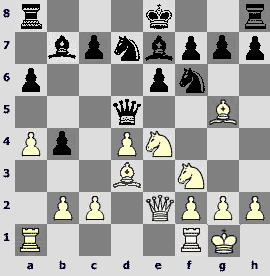
13.c4! bxc3 14.¤xc3 Јa5. Black needs only one move to complete the development, and it is not quite clear whether White can prevent it. Objectively position is equal, but it means nothing, last round has its own rules. Numerous mistakes and blunders are waiting.
15.¦ad1. This move leaves the queenside pawns without protection. 15.¦fd1 would be more accurate, with second rook left on the queenside. It seems that White will be forced to exchange minor pieces on e4, and then the a4-pawn will need protection.
15...¦d8. Good move. Black places the rook in the center and at the same time keeps a bead on the g5-bishop. Let us consider other possibilities.
In case of 15...0–0 16.d5! ¤c5 (16...Ґxd5 17.¤xd5 ¤xd5 18.Ґxe7 ¤xe7 19.Ґxh7+ ўxh7 20.¦xd7 is worse, and White have obvious advantage) 17.Ґc4 ¦ae8 18.Јc2 exd5 19.¤xd5 Ґxd5 20.Ґxd5 Јxa4 21.Јxa4 ¤xa4 22.Ґc6 ¤xb2 23.¦de1 ¤d3 24.¦e3 ¤b4 25.Ґxe8 ¦xe8 White can boast of a slight edge.
Finally, another good way to equality was 15...h6!? 16.Ґd2 (16.Ґf4!? 0–0) 16...Јh5 17.¤e5 Јxe2 18.Ґxe2 c5 19.¤xd7 ¤xd7 20.Ґe3.
16.Ґh4. 16.d5 only helps Black – 16...¤xd5 17.¤xd5 Ґxd5 18.Ґxe7 ўxe7 19.Ґe4 Ґxe4 20.Јxe4 ¤f6. A simple «throw-in» was also interesting 16.¤e5!?
16...c5 [16...0–0!?] 17.Ґb1! Again with a threat of unpleasant 18.d5 in case of 17...0–0.
17...cxd4. After 17...0–0 18.d5 Ґxd5 (18...¤xd5? 19.¦xd5 Ґxh4 20.¦h5, and White wins) 19.¤xd5 exd5 20.Јxe7 ¦fe8 21.Јd6 ¤e5 22.Јxe5 ¦xe5 23.¤xe5 Јxa4 24.Ґxf6! gxf6 25.¤f3 White has better chances thanks to the weakened opponent's kingside while black pawns have problems with moving. 17...Јb4!? 18.d5 Ґxd5 19.¦xd5 was also possible (19.¤xd5!? ¤xd5 20.Ґxe7 ¤xe7 21.¤e5 Јxa4 22.¦fe1© with good compensation for two pawns) 19...exd5 20.¦e1 0–0 (20...c4 21.¤d4‚) 21.Јc2 g6 22.¦xe7 ¦fe8 23.¦xe8+ ¦xe8 24.h3, and it seems that White's position is preferable.
18.¤xd4. It was the last chance to get something out of the opening. Playing 18.¦xd4!? with subsequent ¦fd1, White could have made opponent's task harder. White would have had better position after 18...0–0 19.¦fd1 Ґxf3 (or 19...¤b6 20.b4! Јh5 21.Ґxf6 Ґxf6 22.¦xd8 ¦xd8 23.¦xd8+ Ґxd8 24.Ґe4І) 20.Јxf3 ¤e5 21.Јe2.
18...Јb4! A nice stand for the queen. No more tricks with ¤xe6 и b2-b4, and the h4-bishop does not feel safe any more. 18...0–0?? 19.¤xe6 fxe6 20.Јxe6+ ¦f7 21.Ґa2 ¦df8 22.Јxe7 lost.
19.Ґg3 0–0 20.Ґa2?! [20.Јc2 ¦fe8 21.Јb3 ¦c8 22.Јxb4 Ґxb4 23.¤de2, and Black has a better ending.]
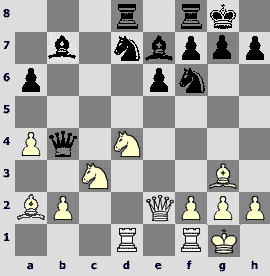
20...Ґc5. Very interesting and non-standard decision. Black voluntary parts with an exchange getting bishops and attacking prospects in return. A simple 20...¤b6! provided Black with comfortable advantage. White cannot protect the a4-pawn: 21.Ґe5 ¤xa4 22.¤xa4 Јxa4 23.Ґc4 a5 24.Ґb5 Јb4і.
21.¤b3 Ґa7!? In case of 21...Ґe7 22.Ґc7 ¦c8 23.¦d4 or 21...¤d5 position is equal.
22.Ґd6 Јh4. 22...Јb6 deserved consideration: 23.Ґxf8 Јc6 24.¤d5!? exd5! [24...¤xd5? 25.¤a5 Јb6 and White stands better (after 25...¤f4? 26.Јg4 Јxg2+ 27.Јxg2 Ґxg2 28.Ґd6 Ґxf1 29.Ґxf4 Ґe2 30.¦d2 Ґf3 31.Ґc7 ¦c8 32.¦xd7 Ґb6 33.Ґc4 Ґxc7 34.Ґxa6 White wins)] 25.¦c1 Јxa4 26.Ґa3 with complex position, in which chances of the opponents are equal. But it wasn't what Black had sacrificed material for.
23.Ґxf8 ¦xf8©. The situation is still very tangled. Both sides have plenty of resources and it is hard to say whether exchange sacrifice is correct.
24.Јd3? 24.¦d3 is interesting, defending 3rd file: 24...¤h5 25.¦xd7 ¤f4 26.¦xb7 Ґb8! 27.h3 ¤xe2+ 28.¤xe2 Јe4 29.¦xb8 ¦xb8 30.¤c3 Јe5 (30...Јc2? 31.¤d4!), and White's position is preferable.
24...¤e5? Forcing the queen where it wants to be – on g3! 24...¤h5! 25.Јxd7 was correct (or 25.Јh3 Јxh3 26.gxh3 ¤e5 27.¦fe1 ¤f3+) 25...Ґxg2, and Black has serious attack in all variations, e.g. 26.¤d4!? ¤f4 27.f3 Јg5‚.
25.Јg3. Now White is OK. 25...Јh5 26.¤d4 ¤g6 27.h3 Ґb8 28.f4 e5!? Play for a win. After 28...¤xf4 29.¦xf4 Ґxf4 30.Јxf4 e5 31.Јf5 exd4 32.Јxh5 ¤xh5 33.¦xd4 White has clear advantage in the ending.
29.fxe5 Ґxe5 30.Јe3 ¤g4?! Black grows excited. 30...¦e8!? 31.Јd2 ¦d8„ was interesting.

31.Јe2??°. Unexpectedly, White parts with the h3-pawn. 31.hxg4™ Јh2+ 32.ўf2 Јxg2+ 33.ўe1 Ґg3+ 34.¦f2 Ґh4 35.¤de2, and White's defensive resources are better than Black's attacking ones, plus White still has an extra rook.
31...Ґh2+ 32.ўh1 Јxh3 33.Ґd5. Black also wins after 33.¤d5 Јh5 34.¦f5 Јh4 35.¤f3 ¤f2+ 36.Јxf2 Јxf2 or 33.¤e4 Ґxe4 34.Јxe4 Јh4.
33...Јh4? Position remains won, but it is a warning bell. 33...Јh5!? 34.¦f5 (34.Ґxf7+ ўh8 35.Ґxg6 ¦xf1+ 36.Јxf1 hxg6, and Black wins) 34...Јh4 35.¤f3 ¤f2+ 36.Јxf2 Јxf2, and White can resign.
34.¤f5 Јh5 35.g3. Both 35.¤e7+ ўh8 36.¤xg6+ hxg6 37.g3 Ґxg3+ 38.ўg1 Ґb8 and 35.Ґxf7+!? ўh8 36.Ґxg6 hxg6 37.¤xg7 ¦xf1+ 38.¦xf1 Јh3 39.¦f8+ ўh7! 40.¤e4 Ґxe4 41.Јxe4 Јh4 42.g3 ¤f2+ 43.¦xf2 Јxe4+ are hopeless for White.
35...Ґxg3+ 36.ўg1 Ґh2+ 37.ўg2 Ґc8? After that the struggle begins again. Black was winning after 37...Ґb8 and the queen invasion cannot be prevented: 38.Ґxb7 Јh2+ 39.ўf3 Јh3+ 40.ўe4 ¦e8+ 41.ўd4 ¦xe2 42.¤xe2 Јb3.
38.Ґxf7+!› ўh8. Black cannot play 38...¦xf7 39.Јe8+ ¦f8 40.¤e7+ ўh8 41.Јxf8+ with the mate.
39.Ґxg6 [39.Јe7 looses because of 39...Ґd6 40.Јxd6 ¦xf7] 39...hxg6? The third mistake during the last 7 moves could have been the last one in the game. After 39...Јxg6 40.¤h4 Јc6+ 41.¤e4 position still remained unclear, it would be the game with three possible results.
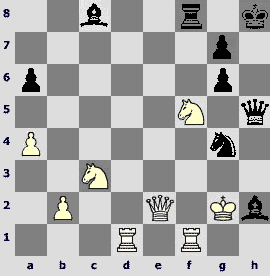
40.¤d6?? What happened to White? Instead of trying to answer I will cite him: 40.¤g3 ¤e3+ 41.Јxe3 Јh3+ (A.Goldin). «The next move I paid attention to – anticlockwise – was 40.¤d6, but then I looked at the clock and ran scared. My intuition let me down that day. The next move in the lane was right. I only had several seconds left and I did not have time to check 40.¤xg7! Ґb7+ 41.¤e4 Јe5 (41...¦xf1 42.¤xh5 ¦xd1 43.¤hf6!ќ) 42.¦xf8+ ўxg7 (or 42...ўh7 43.Јxg4 Ґxe4+ 44.ўh3 ўxg7 45.¦df1, and White wins) 43.¦d7+ ўxf8 44.¦xb7, and White will have no problems with realization of material advantage».
40...Ґxd6°. Now everything is easy. 41.¦xf8+ Ґxf8 42.¦d8 Јh2+ 43.ўf3 ¤e5+ 44.ўe3Јg3+ 0–1
Games of the knock-out tournaments stand apart in this article. In such tournaments every second game is like the last one and the ability to win on demand is highly estimated. Especially when you have to win as Black to continue the struggle.
G.Kacheishvili- V.Kotronias B07
World Championship, Tripoli 2004
1.d4 ¤f6 2.g3. As you can guess by this move, Kacheishvili won the first game as Black. Still he could have tried to play the opening slightly more fundamentally.
2...g6 3.Ґg2 Ґg7 4.e4 d6 5.¤c3 0–0 6.¤ge2 ¤a6 7.0–0 c5 8.h3. Useful preventive move.
8...cxd4
8...¦b8?! 9.Ґe3 b6 10.e5 ¤e8 11.exd6 ¤xd6 12.Ґf4 Ґb7 13.dxc5 ¤xc5 14.Ґxd6 Јxd6 15.Јxd6 exd6 16.¦ad1 ¦fd8 17.Ґxb7 ¦xb7 18.¦d5І Gagunashvili-Bente, Warsaw 2005.
9.¤xd4 ¤c5 10.Ґe3 Ґd7 11.¤b3. White plays demonstratively solid. No moving forward, pieces are moved to the protected squares. How should Black act in such a situation? Position gives no reason for activity, so the refutation will be very easy to find. He can try to use excessive wish of White for exchanges, but meanwhile he has to play according to the position. 11.Јd2 ¦c8 12.¦fe1 a6 13.a4 e5 14.¤de2 Ґc6 15.f3 Јd7› Sepp – Gagunashvili, Plovdiv 2003.
11...¤a4 12.¤xa4 Ґxa4
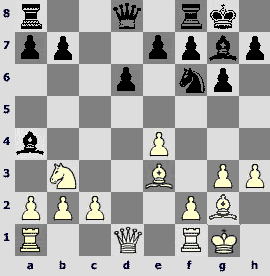
13.¤d4?! The first warning bell. White missed a strong jab 13.e5!?
a) 13...¤e8 14.Ґxb7 ¦b8 (14...Ґxe5 15.Ґxa8 Јxa8 16.Ґd4±) 15.Ґg2 Јc7 16.Јd4!;
b) 13...¤d7? 14.exd6 Ґxb2 15.¦b1 Ґe5 16.dxe7 Јxe7 17.Ґxb7 ¦ad8 18.Јc1± (J.Nilssen-Burgess, Arhus 1989), and no compensation for the pawn is seen;
с) 13...dxe514.Ґxb7 ¦b8 15.Јxd8 ¦fxd8 16.Ґg2 a6 17.¦fd1І. White's position is preferable, but it seems he did not want to make any inequality on the board – Black's play here is very obvious (although White's play is even more obvious).
13...Ґd7. For the next few moves the opponents position their forces on the strongest available squares.
14.Јd3 ¦c8 15.c4 Јa5 16.¦fd1 ¦fd8 17.a3 a6 18.¦ac1 Јc7 19.b3 Enormous margin of safety is seen in every White's move. 19.b4!? Јb8 20.ўh2 b5?! 21.cxb5 axb5 22.¤b3І.
19...Јb8 20.a4. Play aimed at restricting the opponent. "We need nothing until others also have nothing".
20...b6 21.¤c2 a5. An aggressive move. Kotronias starts his play for a win, fixing the queenside at the beginning.
22.Ґd4 Ґc6 23.¤e3 ¤d7 24.¤d5 ¦e8. 24...Ґxd5?! – it is well-known that after such exchanges White's position is usually better, especially with the queenside locked. 25.exd5 Ґxd4 26.Јxd4 Јc7 27.¦c3 ¦e8 28.¦e3І.
25.Ґxg7 ўxg7 26.h4 e6!
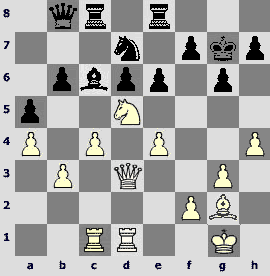
The first bridge is burned. He could not stay there any longer– there was a danger of being squeezed.
27.¤c3. The pawn must be captured. Position after 27.Јc3+?! f6 28.¤e3 ¤c5 29.f3 ¦cd8› is really unclear.
27...¤c5 28.Јxd6 Јb7. The only way. Queens on board secure counterchances even in case of White having an extra pawn.
28...Јxd6? This move is objectively strong. It bears a question-mark because of the situation in the match. 29.¦xd6 ¦ed8 30.e5 Ґxg2 31.ўxg2 ¦xd6 32.exd6 ¤xb3 33.¦d1 (33.¦b1 ¤d2 34.¦xb6 ¤xc4 35.¦a6 ¤xd6µ) 33...¤c5 34.f4 ¦d8 35.ўf3 h5=.
29.¦b1 e5 30.f3? The second bell. Usually a good active game leads to a draw easier than a cautious and solid one. 30.h5! gxh5 would be extremely strong and unexpected move(30...¦e6? 31.h6+ ўxh6 32.Јd2+ ўg7 33.Ґh3 Ґxe4 34.Ґxe6 ¤xe6 35.¤xe4 Јxe4 36.Јe3±; to play for victory one should make 30...h6!? but that is quite another matter, you should agree) 31.Јd2 ¤xe4 32.¤xe4 Ґxe4 33.Јg5+ ўf8 34.Ґxe4 Јxe4 35.Јxh5 ¦c6ч 36.¦e1 Јg6 37.Јxg6 hxg6 38.¦bd1=, and this position could not be won by Vasilios from my point of view.
30...f5 31.exf5?! There was no use relieving the tension. 31.h5!?
31...gxf5 32.Јd2. Here 32.h5?! is not that good: 32...Ґxf3 33.h6+ ўg8 34.Ґxf3 (34.¤d5? Ґxg2 35.¤f6+ ўf7 36.¤xe8 ¦xe8°) 34...Јxf3 35.Јd5+ Јxd5 36.¤xd5 ¦e6„.
32...ўh8 33.¤d5 ¦g8
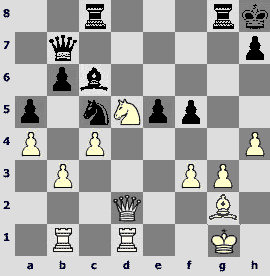
Black's achievements are evident. He got some play for a pawn, and the absence of that pawn does not tell yet. And what is extremely important, it is the play against the king. As you know, it is exactly what the players who are eager to make a draw are mostly afraid of.
34.ўh2 Ґxd5 [34...Јg7 35.Јg5!] 35.cxd5. White got a passed pawn. 35...Јg7 36.Јg5 Јf7 37.Јe3 Јf6 38.f4. When White was pressured to the rope, he finally made a principled move. 38.Јf2? ¦g7 39.Ґh3 ¦cg8 40.¦g1 f4 41.g4 ¦d8ѓ.
38...exf4
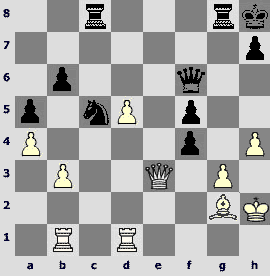
39.Јd4?? Nerves, nerves, nerves... I cannot say that White was afraid of something ephemeral – Black really had some threats, but after this move White's position is lost! There was a possibility to find the decision by contradiction. The right one is 39.Јxf4 ¦g4 40.Јd2 f4 (40...¦cg8 41.Јb2!), and in this critical position, which Giorgi without any doubt reached in his calculations, White has a good move 41.Ґh3! After that White does not risk losing. But here one has to calculate till the end. Possibly the Georgian chess player did not have enough time to do that.
41...fxg3+? 42.ўg1 (42.ўg2 ¦xh4 43.Јb2 Јxb2+ 44.¦xb2 ¦d8і) 42...¦xh4 43.¦f1 (43.Ґxc8? Јf3 44.Јg2 Јe3+ 45.ўf1 ¦h1+ 46.Јxh1 Јf2#) 43...¤e4 44.¦xf6 ¤xd2 45.Ґxc8 ¤xb1 46.d6 ¦d4 47.d7 ўg7 48.¦e6ќ;
41...¦xg3 42.Јd4 ¦f8 43.d6 Јxd4 44.¦xd4 ¦xb3 45.¦xb3 ¤xb3 46.¦d1І.
39...fxg3+ 40.ўh3 ¦cf8 41.Јxf6+ ¦xf6 42.¦d4 [42.Ґf3 f4 43.ўg2µ] 42...f4 43.¦f1 ¦gf8 44.¦f3 ¤d7
45.d6? Loses immediately. There was a chance to struggle after 45.¦e4µ.

45...¤e5!° 46.d7 ¤xf3 47.d8Ј ¤g1+ 48.ўg4 ¦g6+ 49.Јg5 ¦1xg5+ 50.hxg5 f3 51.¦d ¤e2 52.Ґxf3 ¦f4+ 53.ўh5 ¦xf3 54.ўh6 ўg8 0–1
Having won back, Kotronias made an inspired tie-break and passed to the next round. This example shows that even making solid moves as White is not enough for a draw. Sooner or later one has to play concrete, and it would be easier to start from the very beginning.
A.Lastin – Z.Azmaiparashvili B07
World championship, Tripoli 2004
The Georgian player was defeated in the first game. Only this can explain such pretentious opening.
1.e4 d6 2.d4 ¤f6 3.¤c3 ¤bd7 4.g4! A two-time Bronze Medal winner and ex-champion of Russia is a player of the principles. Black plays passive opening, so why not seize the space? I suppose in case of a poll among the members of the world championship about what they should do in such a position, bearing in mind that a draw suits them, there would be few to agree with Lastin. It makes me sympathize Lastin even more.
4...h6 5.Ґe3 e5 6.h3 a6
6...c6 7.¤ge2 b5 8.Ґg2 Ґb7 9.a3 a5 10.d5 b4 11.dxc6 Ґxc6 12.¤d5 Јb8 13.Јd2 bxa3 14.bxa3 Ґxd5 15.exd5 Ґe7„ Hector-Bauer, Leon 2001; 6...d5!? 7.dxe5 (7.exd5 e4 8.Ґg2 Ґb4 9.¤ge2 ¤xd5„) 7...¤xe4 8.¤xe4 dxe4 9.Јd4 with possible numerous exchanges.
7.a4 b6 8.Ґg2 Ґb7 9.¤ge2 Ґe7 10.0–0 [10.f4?! c5 11.dxe5 dxe5 12.0–0 c4 (12...0–0 13.g5 hxg5 14.fxg5 ¤e8 15.h4І) 13.¤g3 0–0›] 10...h5?! Why should he allow White to press even more?
11.g5 ¤h7 12.h4 ¤hf8 13.f4І
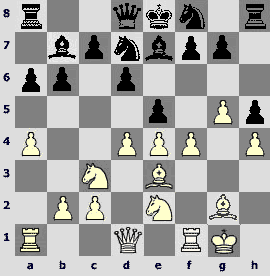
White got a huge space advantage in the opening. But there is a hidden danger – in the future, very faraway future, which very likely will not be seen by Black, white king becomes weak.
13...¤g6 14.Јe1 exf4 15.¤xf4 ¤xf4 16.¦xf4 [16.Ґxf4 0–0 17.¤d5 ¦e8 18.Јg3±] 16...0–0 17.Јf2 Јe8 18.¦f1 c5 19.Ґh3. White's advantage increases quickly and Black, despite some exchanges, will have no pieces to move soon. 19.¤d5!? Ґxd5 (19...Ґd8 20.Јf3 f6 21.Ґh3±) 20.exd5 cxd4 21.Ґxd4 Ґd8 22.Ґh3± is also very good.
19...cxd4 20.Ґxd4 ¤e5 21.Јe2 g6 [21...f6? 22.Ґe6+ ўh8 23.¤d5 (23.Ґd5!?) 23...Ґd8 24.gxf6 Ґxf6 25.¤xf6 Јg6+ 26.ўh2 ¦xf6 27.¦xf6 gxf6 28.Ґf5± with overwhelming advantage] 22.Ґxb6±
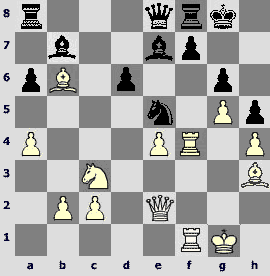
Black has a bad position, he is a pawn down, and has to win. The main thing is not to panic! After all, as my coach Alexei Mikhailovich Juneev says, "Games are not won, games are lost". Despite seeming paradoxicality of the utterance, it seems rather fair to the author.
22...ўg7 23.Ґd4. 23.Јf2!? deserved he most fixed attention, depriving Black of any play.
23...f6 24.gxf6+. 24.¤d5!? Ґxd5 looked stronger(24...fxg5!? 25.¦xf8 Ґxf8 26.¤c7 Јe7 27.¤xa8 Ґxa8±, and Black has slight winning chances, although White has to be precise) 25.exd5 Јd8 26.Ґe6ќ.
24...Ґxf6 25.Јf2 Јe7 26.¤d5 Ґxd5 27.exd5. Black finally activates at least one piece.
27...¦ab8 28.Ґc3 ¦b7 29.Ґe6 a5 30.ўg2 ¦c7 31.Ґd4. 31.Ґxa5 is stronger, but then 31...¦c4! results in a small mess.
31...¦b7 32.Ґc3 ¦c7 33.Јe2! The mark for bravery. White rejects a draw! (Although it is quite clear that Azmaiparashvili would not repeat the position once more).
33...¤d7
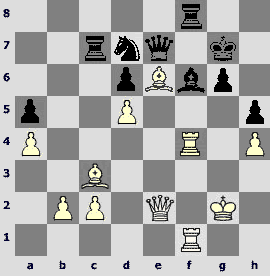
34.Ґxf6+?! Unfortunately, Alexander begins to lose the thread of the game. He could just capture a pawn – 34.Ґxa5!?
34...¦xf6 35.¦xf6 ¤xf6 36.Јd3 (the threat was 36...¤d5!) 36...¦b7 37.b3 ¦b8 [37...¦b4!? 38.c4 ¦b8] 38.Јc3? Forces are leaving the courageous fighter. 38.¦f3! ¦b4 39.c4ќ – White moves the queen on g5, and after that Black can resign easily.
38...¦b4 39.ўh3 ¦e4! This rook transfer seems to be a surprise for White.
40.Јg3 [40.¦f3!?] 40...¦e5 41.Јf4 ¦e4 42.Јf2. There is a unique chess player commanding White forces. Either it is a play for victory or Alexander underestimated the perspectiveness of the f-file invasion by the rook and not the queen.
42...Јd8 43.c4 ¤h7!„
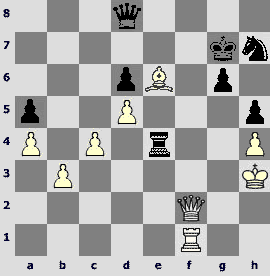
FIDE Vice-President caught his chance – somewhere far away appeared a hope of favorable outcome...
44.Јb2+ [44.Јg3!? ўh6 45.¦f7 Јb6! 46.ўg2 Јd4„] 44...ўh6 45.Јd2+ g5 46.hxg5+. The Russian was possibly unable to uncork 46.Јc3!? It is not criticism, not at all – strength of almost all chess players decreases when their position was just overwhelming, and suddenly they need to be precise in their moves.46...¦xh4+ 47.ўg3 ¦e4 48.¦f7 ¦e5 49.Ґf5 ¤f8 (49...¤f6 50.Јf3 …Јh8 51.Ґc2!ќ) 50.Ґc2ѓ, and White gets the initiative, although the game can end either way.
46...Јxg5 47.Јxg5+ ¤xg5+ 48.ўg2 ¦e2+ 49.ўg1?! White fails to make the last effort, that is calculating a long variation. Author tends to suppose that this move would have been more preferable even according to general considerations: 49.¦f2 ¦xf2+ 50.ўxf2 ¤e4+ 51.ўe3 ¤c5 52.ўf4 ¤xb3 (52...ўg6 53.Ґf5+ ўf6 54.Ґc2) 53.ўf5 ¤c5 54.ўf6 ¤xa4 55.ўe7 ¤b6 56.ўxd6 ¤xc4+ 57.ўc5 ¤e5=, and only in the Silvio Danailov tournaments struggle would go on.
49...¤e4 50.b4?! The wish to get counterplay as soon as possible is quite understandable, but passive defense would be better – 50.Ґh3!?
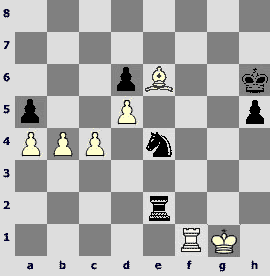
50...axb4 51.¦b1 ўg5 52.Ґh3? Hara-kiri. The bishop is attacked. 52.¦xb4 ¦a2!? [52...ўf4 53.¦b8! (53.¦b3? ¤d2°)] allowed to stay afloat.
52...¤d2° 53.¦xb4 ўh4 0–1
"Where is justice?" – a reader may cry. Black selects let us say a wrong opening, White plays in a principled and strong manner, and... loses. But I warned you: this article is not about chess. It is rather about struggle.
P.S. Nevertheless Lastin won in the tie-break.
It seems that an obligatory victory as White can be achieved relatively easily. But there is a question of the strategy: whether one has to press carefully in the position with slight advantage or to start a hard struggle with slightly higher chances for the victory? Everyone has to decide himself, there is no universal way.
A. Khalifman – G.Kamsky E15
World Championship, Las Vegas Лас-Вегас 1999
In this game the future world champion had a hard task. And not only a hard one, it was a turning point of the tournament for a Saint Petersburg inhabitant. It was never and for nobody easy to overpower Kamsky. And to do that on demand is an outstanding skill.
1.¤f3 ¤f6 2.c4 e6 3.d4 b6 4.g3 Ґa6 5.b3 Ґb4+ 6.Ґd2 Ґe7 7.Ґg2 c6 8.Ґc3 d5 9.¤bd2. An exchange sacrifice similar to the sacrifice in the game, although in the other version, was offered in winter by the Indian fakir. 9.¤e5 ¤fd7 10.¤xd7 ¤xd7 11.¤d2 0–0 12.0–0 ¤f6 13.e4 b5 14.exd5 cxd5 15.c5 b4 16.Ґxb4 Ґxf1 17.Ґxf1 e5 18.Ґc3± Anand-Adams, Wijk aan Zee 2005.
9...0–0 10.Јc2 ¤bd7 11.e4 ¦c8 12.0–0 ¤xe4N 13.¤xe4 dxe4 14.Јxe4 b5
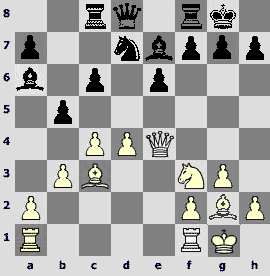
15.c5! This decision is right from all points of view. Here one should bear in mind that firstly Khalifman likes to play without material but with the initiative and is skilled at it, secondly that it is impossible to defeat such an opponent in the quiet maneuvering way, and thirdly that in case of any imbalance (here White has initiative and Black has material) it is easier to win. 15.¤d2?! bxc4 16.bxc4 ¤b6; 15.¤e5 ¤xe5 16.dxe5 bxc4 17.bxc4 Ґc5.
15...b4 16.Ґxb4 ¤f6 17.Јe1!? [17.Јc2] 17...¤d5 18.Ґa5 Јe8 19.Јe4 Ґxf1 20.Ґxf1. So, Black wins an exchange, but white bishops control the major part of the board and black rooks do not have open files. Moreover, White has pawn advantage on the queenside.
20...Ґf6 21.h4 g6 22.h5. One more sacrifice. He need not have hurried – 22.Ґd2!? Ґg7.
22...Ґd8?! [22...Ґg7 23.hxg6 hxg6 24.¦e1©] 23.Ґd2. Of course not 23.Ґxd8 Јxd8 24.hxg6 hxg6 25.¤e5 ўg7і, and White's compensation almost disappears.
23...f5?! One has to be a man of the principles till the end: 23...¤f6!? 24.Јe1 (24.Јe3 ¤xh5 25.Јh6 Ґf6 26.¤g5 Ґxg5 27.Ґxg5 Јd7µ) 24...¤xh5 25.Ґh6 ¤g7 26.Ґa6 ¦c7 27.Јe4 f6 28.b4©. Black pieces are a pitiful sight but their position is still rather stable.
24.Јe2 gxh5
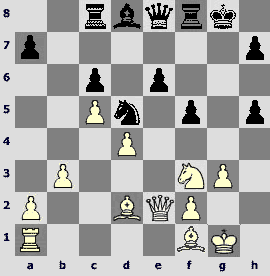
Meanwhile White successfully conducts his plan: increases the tension and sneers at the opponent's pawn structure.
25.¦e1І ¦f6 [25...h4?! 26.Јxe6+ Јxe6 27.¦xe6 ¦f6 28.Ґa6!±] 26.Ґh3! Binding Black, who now needs to keep an eye on the e6-pawn.
26...h6 27.¤h4 Јf7 28.Ґg2 Ґc7 [28...f4? 29.Ґh3!] 29.Ґf3. Flowing maneuvers of the white bishop show the spirit of the position better than words.
29...Јg7 30.Јa6 Јd7. Black has to defend against local threats permanently having no chance to start the attack. 30...¦d8?! 31.Јxc6 (31.Ґxh5? f4 32.g4 f3„) 31...Ґxg3 32.¤g2! Ґf4 33.Ґa5 Ґc7 (33...¤c7 34.ўh1! ¦xd4 35.¤xf4 ¦xf4 36.Ґxc7 ¦xf3 37.Јxf3 Јxc7 38.¦g1+±) 34.Ґxd5 Ґxa5 35.¦xe6 ¦xe6 36.Јxe6+ ўh8 37.ўf1±.
31.Ґxh5 Ґb8. There again was no way to break free from the grip: 31...f4?! 32.g4 f3 (32...¤e7 33.¤f3) 33.g5 (33.¤g6!?) 33...hxg5 34.Ґxg5 ¦ff8 35.Ґg4 ¦ce8 36.Јd3!±, and the bishops defend his king much better than pawns.
32.¤f3 ўh7 33.¤e5!
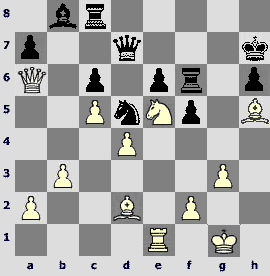
White presses the weakness on c6, hoping to get to h6 in perspective. The play all over the board!
33...Ґxe5 34.dxe5 ¦ff8 35.Јe2 ¦g8?! The rook is better on the f-file. It was better to transfer the queen – 35...Јg7! 36.ўg2 (36.Ґf3?! f4 37.g4 h5) 36...f4 37.Ґg4 (37.¦h1 ¦f5!; 37.Ґf3?! fxg3 38.fxg3 ¤f4+ 39.Ґxf4 ¦xf4 40.Ґe4+ ўh8„) 37...¦ce8 38.¦h1ѓ.
36.ўg2± Јg7. Now queen cannot help here. 36...Јc7!? 37.¦h1±.
37.¦h1 f4? Decisive mistake. 37...Јf8? 38.Јc4! ¦c7 39.Јh4 ўh8 40.Ґf7!ќ; only 37...Јc7allowed to continue the game.
38.Ґf3. Possibly an easier victory would be achieved with 38.Јe4+! ўh8 39.Ґf7 Јxf7 (39...¦gf8 40.Ґxe6 ¦ce8 41.Ґxd5 cxd5 42.Јxd5 ¦d8 43.Јc6ќ) 40.¦xh6+ ўg7 41.¦h7+ќ.
38...¦gf8. Guilt admittance does not set one free from the responsibility.
39.Ґe4+ ¦f5 [39...ўg8 40.¦h4; 39...ўh8 40.Јh5] 40.Ґxf5+ exf5 41.Јh5 Јg6 42.Јxg6+ўxg6 43.ўf3 ¦d8 44.Ґxf4ќ
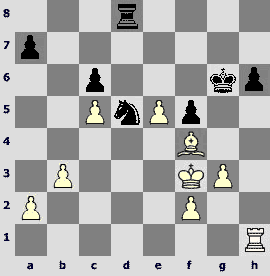
White's position is completely winning. Kamsky checks psychological stability of the opponent.
44...h5 [44...¤xf4 45.ўxf4 ¦d4+ 46.ўf3 ¦d5 (46...¦e4 47.¦d1ќ) 47.¦e1 ўf7 48.ўf4 ўe6 49.¦h1 ¦d4+ 50.ўf3 ўxe5 51.¦xh6ќ] 45.¦d1 ўf7 46.¦h1 ўg6 47.¦e1 ¤b4 48.¦e2 ¤d3 49.e6 ¤xc5 50.e7 ¦e8 51.¦c2 ¤d3 52.¦xc6+ ўf7 53.Ґd6 ¦xe7 54.Ґxe7 ¤e5+ 55.ўf4 ¤xc6 56.Ґc5 ўe6 57.b4 a6 58.ўg5 ¤e5 59.ўxh5 ўd5 60 .ўg5 ўe4 61.f4 ¤d3 62.Ґe7 ¤b2 63.a3 ¤d1 64.a4 ¤c3 65.b5! axb5 66.a5 ¤d5 67.a6 1–0
Now there will be fragments that characterize the phenomenon of the last round most strikingly.
Xie Jun – P.Harikrishna
World Championship, Tripoli 2004
Harikrishna won his first game, so a draw suits him. But the situation is far from draw here. The following chain of blunders is amazing for a game of such qualified players. Possibly it is the result of high tension.

23.¤d4?? White suggests knight exchange without taking an elegant blow into account. He had to choose an easy 23.e5!? ¦xc3 24.¦b1±.
23...¤f4?? 23...Ґxd4 24.cxd4 could easily win, and here one had to see an easy idea of 24...¤f4 25.Јe5 Јxf1+! 26.ўxf1 ¦c1#.
24.Јd7?? White does not feel the danger. An offer of queen exchange would be more logical – 24.Јd6±.
24...h6?? It is funny, but White is "forgiven" for the second time. 24...Ґxd4 25.cxd4 (in this case White has an alternative, although not a very pleasant one – 25.Јxd4 ¤e2+) 25...Јxf1+ 26.ўxf1 ¦c1#.
25.Ґd6ќ. A sequence of mistakes is over. Black has no hope.
25...¤d3 [25...Ґxd4 26.Ґxf4] 26.h5 ¤e5?? Position cannot be won, but it was no use to lose in three moves.
27.Ґxe5 Ґxe5 28.hxg6 fxg6 29.Јd5+ 1–0
It seems that future U-20 world champion could not bear the tension of the game. The reason of White's tactical blindness is incomprehensible, because he played other part of the game rather well.
A.Zontakh-I.Yagupov D13
St. Petersburg 2003
Andrey Zontakh is a strong and stable Ukrainian grandmaster. The things that happened in this game could only occur in the last round.
1.d4 d5 2.c4 c6 3.¤f3 ¤f6 4.¤c3 e6 5.cxd5. 5.Ґg5!? or 5.e3!? are more principled.
5...cxd5. A strange decision. Black is allowed to put the c8-bishop into the game but he does not want to do that. But tastes differ of course.
6.Ґf4 ¤c6 7.e3 ¤h5 8.Ґe5. Citron-Botvinnik game developed in a similar manner. Mikhail Moiseevich in his annotations considered this White's reaction to the attempt of exchange the most suitable one.
8...f6 9.Ґg3 Јb6 10.a3. Not a bad move, but at the same time the first step to the catastrophe. Why not just defend the pawn? – 10.¦b1.
10...Ґd7 11.Ґd3 f5
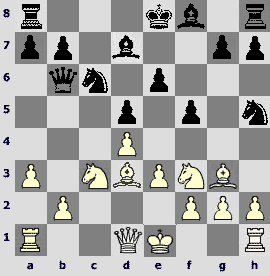
12.¤e5?? Where? What for? He could have saved the bishop and play a better Stonewall: 12.Ґh4!?І.
12...¤xg3µ 13.¤xd7?? He had to play 13.hxg3 ¤xe5 14.dxe5 Јxb2 15.¤e2µ, and Black would have to think.
13...Јxb2° 14.¤b5?? Yielding a rook. 14.¤a4 Ґb4+ 15.axb4 Јxb4+ 16.Јd2 Јxd2+ 17.ўxd2 ¤xh1° was also hopeless.
14...¤xh1 15.Ґe2 Ґb4+ 16.ўf1 ўxd7 17.¦b1 Јd2 18.Јb3 ¤xf2 19.ўxf2 f4 0–1
To gain the victory Black just had to punish White for the extremely bad play in the end of the opening.
A.Ilyin-N.Vitiugov D25
Smolensk 2001
The last round of the U-14 championship of Russia. Black needs to win to get the second place (by this time no one could overtake Andreikin) and for White a draw is suitable.
1.¤f3 d5 2.d4 ¤f6 3.c4 dxc4. A paradoxical opening of the play for the victory. But let bygones be bygones...
4.e3 Ґg4 5.Ґxc4 e6 6.¤c3 ¤bd7 7.0–0 Ґd6 8.h3 Ґh5 9.Ґe2 c6 10.e4 Ґxf3 11.Ґxf3 e5 12.d5 c5 13.¤b5 Ґb8 14.a4 0–0 15.Ґd2 ¤e8 16.Јb3 a6 17.¤a3 ¤d6 18.¦fc1
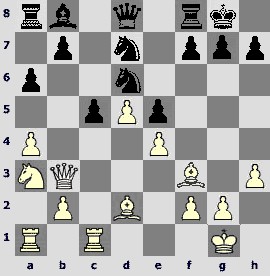
Black's position is bad but strong. One can struggle forever. But the position should be strengthened step by step. An important detail: the situation is imbalanced (black knight for white bishop), and this frequently raises the chances of playing for a win.
18...f5?? Instead of that the 14-year-old youngster thinks he was a hero of American action movie. He supposed the sudden war-cry at the appropriate moment was enough for the victory.
19.¤c4!± Strategically Black's position is lost. He can resist, struggle for a draw, but not for the victory.
19...¤xe4? [19...¤f6 20.Ґg5±] 20.Ґxe4ќ fxe4 21.Јxb7 [21.d6! was even more strong] 21...¦a7 22.Јc6 ¤f6 23.Ґe3 ¦af7 24.Ґxc5 ¦e8 25.d6 ¤d7 26.Ґe3 ¦ef8 27.Јxe4 ¤f6 28.Јc6 ¤h5 29.¤xe5 ¦f5 30.¤d7. It's time to stop beating. 1–0
This game is an example of how one should not play in the most crucial games. As wise ancient Latins said, hurry slowly.
And two psychological sketches in the end.
P.Negi – V.Georgiev C78
Wijk aan Zee 2005
A noteworthy game. I go mad when sportsmen not overburdened with brains, say aloud something like "It is football (hockey, boxing, basketball – choose whatever) and not chess! You have to struggle, make decisions in a fraction of second, and to stand on the playground pretending to be thoughtful" Or something like: "Hey, guys! Don't be apathetic, it is not chess". But what I really like is when football commentators try to show their enormously broad intelligence (they would better follow the news, transfer gossips etc.) and say that "speed is not quite high, teams play cautious football, it is almost chess". People always hate things that are out of their understanding. But why do they mock at this small group of people who felt curious about this unknown and then something grew out of this interest? Why are chessplayers so often spoken of in vain? We even do not wear suits, do not take taxi, so we cannot expose people to class odium. So why everyone thinks that, pardon my words (it is a painful topic), the football player of the middling club of the first league, who digs the soil with his face, is the man who works hard to earn his money and he should get this money, he has a risk of getting a serious injury playing for his village, and a grandmaster is a classic example of a hanger-on. He wants a lodging and food and some of those even expect money for their games. And during the game they just try to look serious, sit for a couple of hours and go back home. Everyone who saw it at least once tends to think, "I can also do so without a problem!" And you cannot properly analyze the game afterwards during some mass open, someone will come and say that you should have made a knight move.
Excuse me for such a long digression. Let us turn to the game. The annotations will be as short as possible. Georgiev has to win – then he becomes the winner of Wijk aan Zee C. All the places from the 2nd to the 5th are more or less the same in the tournaments of that kind. And the winner gets a lot – money, glory, prestige, and lots of invitations in future. So, it is a classic example of the extremely wanted victory.
1.e4 e5 2.¤f3 ¤c6 3.Ґb5 a6 4.Ґa4 ¤f6 5.0–0 b5 6.Ґb3 Ґc5 7.a4 Ґb7 8.d3
8.¤c3 b4 9.¤d5 ¤d4 10.¤xd4 Ґxd4 11.c3 bxc3 12.bxc3 Ґa7 13.d4 ¤xd5 14.exd5 exd4 15.¦e1+ ўf8 16.d6 cxd6 17.Јh5 Јf6 18.Ґg5 Јg6 19.Јxg6 hxg6 20.¦e7 d5 21.¦xd7 Ґc6 22.¦c7 Ґe8 23.g3 Ґb6 24.¦b7 Ґa5 25.Ґxd5 Ґxc3 26.¦ab1 ¦h5 27.h4 ¦xg5 28.hxg5 ¦d8 29.Ґc4 d3 30.¦b8І Cheparinov-Stefanova, Wijk aan Zee 2005.
8...b4 9.¤bd2
9.c3 d6 10.¤bd2 0–0 11.¤c4 h6 12.¦e1 bxc3 13.bxc3 a5 14.d4 exd4 15.cxd4 Ґb4 16.Ґd2 d5 17.exd5 ¤xd5 18.¦c1 ¦a6› Smirin-V.Georgiev, Minneapolis 2005.
9...0–0 10.¤c4 ¦e8 11.Ґe3 Ґf8. Avoiding exchanges from the first moves.
12.¤g5 d5!
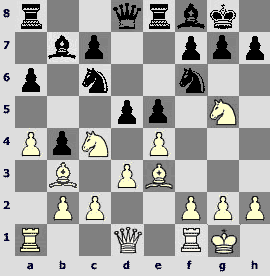
The attack on White's centre is the beginning of tough struggle.
13.exd5 ¤d4 14.Ґxd4 exd4 15.d6. This is not a sacrifice. 15.¤a5?! Ґxd5 16.¤c6 Јd7 (16...Ґxc6 17.¤xf7 Јe7 18.¤h6+=) 17.¤xd4 c5 18.Ґxd5 Јxd5 19.¤df3 h6 20.¤h3 g5!ѓ is weak.
15...Ґd5™ 16.dxc7 Јxc7 17.¤d2 ¦e5 [17...Ґd6!?] 18.Ґxd5 [18.¤df3!? ¦f5 19.Ґxd5 ¦xd5 20.¤e4] 18...¦xd5 19.¤de4 ¤e8. Knight on a rim is better than a knight off the board.
20.¦e1 ¦c8 21.¦c1 g6. Activating the knight. 21...Ґe7!? 22.¤f3 Јd7.
22.Јd2?! 22.Јg4! Ґe7 (22...f5?! 23.Јh3 fxe4 24.Јe6+ќ) is more active.
22...Јc6 23.b3 Ґh6 [23...f5 24.¤g3 Ґh6„ is stronger] 24.f4 a5?! [24...f5!?] 25.¤f3 ¤c7 26.g3 f5. Now this advance is not so effective.
27.¤eg5 Ґg7 28.Јg2 h6 29.¤h3 ¦c5 30.¤d2 ¤d5 31.¤c4. White c4-knight is like a bone lodged in a throat, it does not give a chance to play at all.
31...Јd7 [31...¦e8] 32.¦e2 ¤e3!©
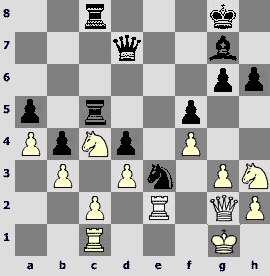
The price does not matter, he needs victory.
33.Јf3 ¦d8 34.¤f2 g5 35.¤xe3 [35.fxg5 hxg5 36.Јh5 brings Black certain problems] 35...dxe3 36.Јxe3 Ґd4 37.Јe6+ Јxe6 38.¦xe6 ўf7 [38...¦dc8!?] 39.¦e2 [39.¦xh6 gxf4 40.gxf4 Ґe3 41.¦e1 ¦g8+ 42.ўf1 Ґxf4„] 39...¦dc8 40.ўg2. White is pressed. Black could have continued repression, but they are anxious to play the material back.
40...¦c3?! 40...g4!? or 40...gxf4!? was possible.
41.fxg5 hxg5 42.g4! White activates the knight. 42...¦xb3 43.cxb3. It seems that 43.¤e4! could win an exchange immediately. But I will tell you confidentially now this does not matter at all. 43...fxe4 44.¦f1+ ўg8 45.cxb3 exd3 46.¦d2±.
43...¦xc1 44.gxf5 ўf6. 44...¦c3! was stronger with rook on the active position.
45.¤e4+ ўxf5 46.¤d6+ ўf6 47.¦e4
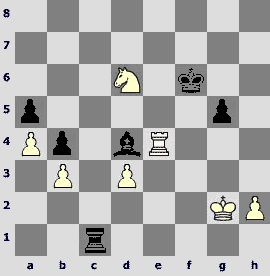
47...Ґe5?! After that Black's position gradually becomes worse, his bishop gets under attacks, and white passed pawn quickly moves to promotion. 47...¦c2+!? 48.ўf3 Ґa7.
48.¤c4 Ґc7 49.d4?! It seems it gives up a pawn. 49.h4!?
49...¦c2+ 50.ўf1 Ґxh2 51.d5 ўf5 52.¦d4 ¦c1+ 53.ўg2 Ґe5 [53...Ґf4 54.d6 ¦c2+ 55.ўf1 ¦c1+, and Black has a draw, but what for?] 54.¦d2 Ґc7 55.d6 Ґd8 56.¦e2 ¦c3 57.¦e8 Ґf6 58.¤xa5 ¦c2+ 59.ўf1 ¦c1+ 60.¦e1 ¦c3 61.¦d1 ¦h3 62.ўg2 ¦c3 63.d7 Ґd8 64.¤b7ќ

Victory floats away... But it is badly needed, so it will be gained. Does he have to take one chance out of thousand? He can do it to win.
64...Ґc7 65.d8ЈҐxd8 66.¦xd8 ¦xb3 67.¦d5+ ўf4 68.a5 ¦b2+ 69.ўf1 b3 70.¦b5 ¦b1+ 71.ўe2 ¦b2+ 72.ўd3 ¦a2 73.¦xb3 g4 74.¦b6 g3 75.¦g6 g2 76.ўc4 ўf3 77.ўb5 ¦b2+ 78.ўc6 ¦a2 79.ўb6 ¦b2+ 80.ўc6 ¦a2 81.ўb6 ¦e2 [a snare is made] 82.¦f6+ ўg4 83.¦g6+ ўf3! Prelude to the combination. And a move of a good psychologist.
84.¦f6+ ўg4 85.¦g6+ ўf5 86.¦g8??
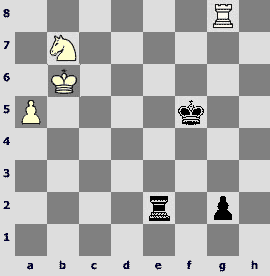
Bingo!
86...¦e6+! 87.ўc7. White still had a study-like way to a draw: 87.¤d6+!! ¦xd6+ 88.ўb7 ¦g6 89.¦xg6 ўxg6 90.a6=, but he was unable to find it.
87...¦g6, and Black utilized his advantage (0–1).
S.Erenburg-I.Cheparinov
Championship of Europe (tie-break), Warsaw 2005
From my point of view, Ivan Cheparinov was the favorite of this game, but it happened so that he lost the first game as White. Theoretically it is OK, it does not matter whether you are White or Black in a rapid game. After the 45th White's move a following endgame has emerged.
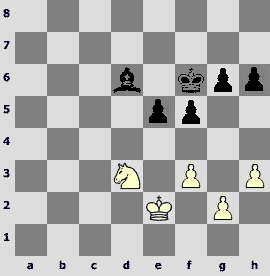
I think that if the Bulgarian had a knight instead of the bishop, the position would be winning. Otherwise it is playable. What should one do in the situation? First of all he had to put the king somewhere on d4. Then he had to limit the knight with the bishop as much as possible, then make about seven wigwag moves and only then move a passed pawn. Even if Ivan's pawn advance was correct, I still recommend waiting a little.
45...e4?! 46.¤f2 Ґc5? And this is an irremediable mistake. Obviously it results from the wish of quick victory.
47.fxe4 Ґxf2 48.exf5!= Ґc5. Oh if there was the Black h7-pawn...
49.fxg6
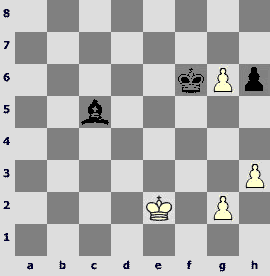
That's all. Sergey Erenburg qualifies for the world championship. Ivan Cheparinov is out. But in this game there were over fifty moves more!!! How can it be explained? The prize is too big. There is no hope that White would make a mistake. The only trap was set on 67th move, and it was a trap only for a second category player. And still Cheparinov is right. One should try to take a chance. Even when there is no chance, when it is clear that you lose it, one has to struggle (some kind of disaster or power crisis can happen). An ability to believe in oneself is the indispensable characteristics of any chess player.
49...ўxg6 50.g4 ўg5 51.ўf3 ўh4 52.ўg2 Ґd6 53.ўh1 Ґc7 54.ўg2 Ґe5 55.ўh1 Ґc7 56.ўg2 Ґd6 57.ўh1 Ґg3 58.ўg2 Ґe1 59.ўh2 Ґc3 60.ўg2 Ґb4 61.ўh2 Ґa5 62.ўg2 Ґc7 63.ўh1 Ґb8 64.ўg2 Ґd6 65.ўh1 ўg3 66.h4 Ґf4 67.g5 Ґxg5
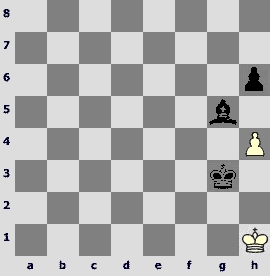
68.h5. Oh hell, he didn't fall into it...
68...Ґc1 69.ўg1 Ґa3 70.ўh1 ўf2 71.ўh2 Ґd6+ 72.ўh1 ўf3 73.ўg1 ўg4 74.ўh1 Ґg3 75.ўg1 Ґh4 76.ўh1 ўxh5 77.ўg1 ўg4 78.ўg2 h5 79.ўg1 Ґg3 80.ўh1 ўh3 81.ўg1Ґc7 82.ўh1 ўg3 83.ўg1 h4 84.ўh1 h3 85.ўg1 ўf3 86.ўh1 ўe2 87.ўg1 Ґg3 88.ўh1 ўf3 89.ўg1 ўg4 90.ўh1 ўh5 91.ўg1 ўh4 92.ўh1 Ґf2 93.ўh2 ўg4 94.ўh1 Ґg1 95.ўxg1 ўg3 96.ўh1 ўf3 97.ўh2 ўg4 98.ўh1 ўg3 99.ўg1 h2+ 100.ўh1 ўh3 Ѕ–Ѕ
And now we will go back to the beginning of the article and remember the identikit of the chess player. You should agree that for us the notion of a good chess player does not usually include the ability to squeeze the victory out of nothing, to reach wanted result having the minimum of resources and to suppress the opponent psychologically. And always and everywhere in any match or tournament everything is decided during one game. And to reach a wanted result one should not necessarily understand well the isolani position or be skilled at rook endings. One should only win a game.
The annotations by A.Goldin, R.Dautov, R.Knaak, M.Krasenkov, D.Temkin, A.Finkel were used in this article.
